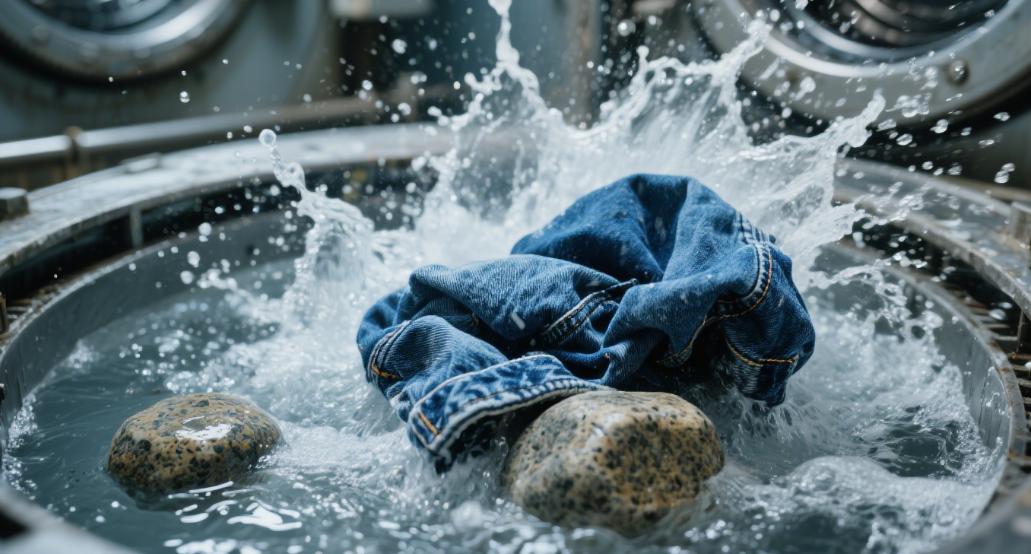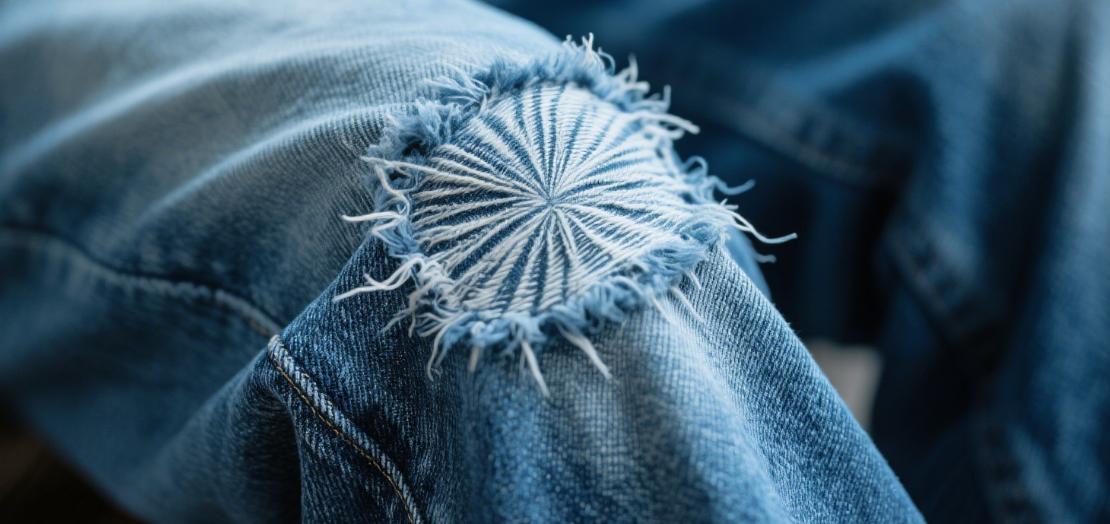In the denim washing process, pumice stone is a core physical abrading material used to achieve a "vintage effect." Its essence lies in creating worn and faded traces that mimic long-term natural wear, while also softening the fabric’s texture—all through mechanical friction that damages the surface yarn structure and dye of denim. Below is a detailed explanation of its working principle, specific effects, process characteristics, and limitations.


1. Core Working Principle: Physical Friction + Selective Abrasion
Pumice stone is a porous, light weight rock formed by the cooling of volcanic magma. It possesses three key properties essential for denim washing: moderate hardness, rough and porous surface, and lower density than water (allowing it to float in washing solutions). When placed in a washing machine, pumice stones collide and rub against denim garments (such as jeans or denim jackets) at high speed with the water flow. This process achieves vintage effects through two key mechanisms:
Damaging surface fibers of the fabric: Friction breaks off some short fibers on the denim surface, creating a "fuzzy texture" that simulates the natural fuzzing and wear caused by long-term use.
Stripping surface dye: Indigo dye— the primary dye used for denim—mostly adheres to the surface of yarns (rather than fully penetrating the fiber interior). The friction from pumice stones selectively peels off the dye on the yarn surface, resulting in "gradual fading" or "local whitening" effects.
2. Specific Effects: Creating Classic Denim Vintage Styles
The role of pumice stone in denim washing ultimately manifests in three dimensions: appearance, texture, and style. It serves as the core technical support for mainstream styles like "vintage denim" and "distressed denim."
|
DimensionofEffect |
SpecificOutcomes |
ApplicationScenarios |
|
Vintage Appearance |
1. Whiskers: Directional friction from pumice stones creates radial faded patterns at joint areas (e.g., waistbands, knee areas of pants), simulating wrinkled wear from natural movement.2. Honeycombs: Dense local whitening marks form at high-friction areas (e.g., pant cuffs, pocket edges), enhancing the vintage vibe.3. Overall Fading: By adjusting pumice stone dosage and washing time, uniform or gradual fading of the fabric—from dark blue to light blue—can be achieved, eliminating the "stiff dyed look." | Vintage jeans, distressed denim jackets |
|
Softened Texture |
Friction from pumice stones breaks down the original tight yarn structure of denim, reducing the fabric’s "stiffness." This allows new denim garments to feel soft and comfortable immediately, without the need for a "break-in" period (especially useful for thick raw denim). | Daily-wear jeans, denim shirts |
|
Styling Differentiation |
By adjusting three parameters—pumice particle size (coarse/fine), dosage (high/low), and washing time (long/short)—different intensities of vintage effects can be achieved: - Coarse pumice + long washing time: Creates "heavy distressing" (e.g., holes, large-area whitening).
- Fine pumice + short washing time: Achieves "light distressing" (e.g., soft gradual fading). |
Street-style denim (heavy distressing), casual denim (light distressing) |
3. Process Characteristics: A Traditional and Efficient Physical Vintage Solution
Compared to chemical distressing methods (e.g., using bleach or enzymes), pumice stone washing offers three core advantages:
Natural-looking effects: The randomness of frictional wear closely mimics "natural wear traces," avoiding the "uniform and rigid fading" caused by chemical agents.



Low cost: Pumice stone is easily accessible and affordable, and it can be reused (in some processes, it is screened and reintroduced for a second cycle).
Broad applicability: It works effectively on all types of denim fabrics (cotton denim, stretch denim), and is particularly suitable for distressing thick denim.
4. Limitations and Alternative Solutions
Despite being a staple in traditional denim washing, pumice stone has obvious shortcomings—driving the evolution of newer technologies:
High fabric damage: Pumice stone’s relatively high hardness can cause yarn breakage after prolonged friction. It is especially unsuitable for thin denim or stretch fibers (e.g., spandex), as it may lead to "uncontrolled hole formation."
Pollution and wear: Friction from pumice stones generates large amounts of rock dust, which mixes into washing wastewater and increases treatment difficulty. Additionally, pumice stones wear down and shrink after repeated use, resulting in solid waste.
Low efficiency: It relies on long periods of agitation in washing machines (usually 1–2 hours), making it unable to support rapid mass production.
As a result, modern denim processes have gradually adopted alternative solutions, such as:
Enzyme washing: Uses biological enzymes (e.g., cellulase) to break down surface fibers of the fabric, achieving gentle fading while reducing fabric damage.
Sandblasting: Uses high-pressure air to spray fine sand or ceramic particles, enabling precise control of local distressing (e.g., "holes" or "whiskers") with higher efficiency.
Laser washing: Uses laser ablation on the fabric surface to achieve digital, contact-free distressing. This method is pollution-free and offers high precision.
In summary, pumice stone is the "cornerstone of physical distressing" in denim washing. Through a simple friction principle, it has created classic vintage denim styles. However, as demands for environmental protection, efficiency, and fabric preservation increase, its application is gradually being replaced by gentler, more efficient processes.
Our main products: Amino silicone, block silicone, hydrophilic silicone,all of their silicone emulsion,wetting rubbing fastness improver, water repellent(Fluorine free,Carbon 6,Carbon 8), demin washing chemicals(ABS, Enzyme, Spandex protector, Manganese remover), Main export countries: India, Pakistan, Bangladesh, Türkiye, Indonesia, Uzbekistan, etc.,more detail please contact : Mandy +86 19856618619 (Whatsapp)
Post time: Aug-27-2025

